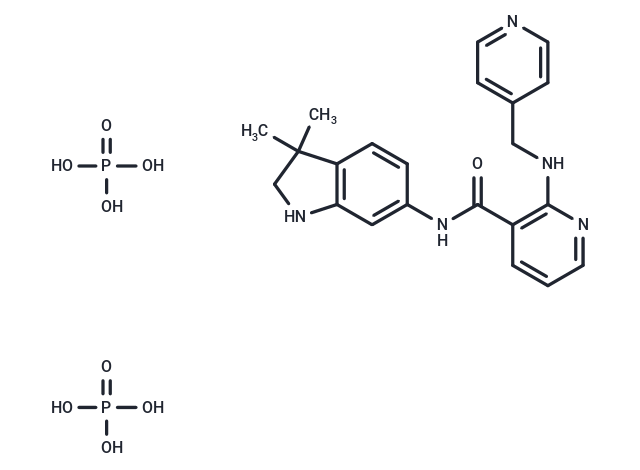Shopping Cart
- Remove All
 Your shopping cart is currently empty
Your shopping cart is currently empty
Motesanib Diphosphate (AMG 706) is the orally bioavailable diphosphate salt of a multiple-receptor tyrosine kinase inhibitor with potential antineoplastic activity.

| Pack Size | Price | Availability | Quantity |
|---|---|---|---|
| 5 mg | $36 | In Stock | |
| 10 mg | $52 | In Stock | |
| 25 mg | $97 | In Stock | |
| 50 mg | $171 | In Stock | |
| 100 mg | $297 | In Stock | |
| 500 mg | $728 | In Stock | |
| 1 mL x 10 mM (in DMSO) | $54 | In Stock |
| Description | Motesanib Diphosphate (AMG 706) is the orally bioavailable diphosphate salt of a multiple-receptor tyrosine kinase inhibitor with potential antineoplastic activity. |
| Targets&IC50 | c-Kit:8 nM, VEGFR2/Flk1:6 nM, VEGFR1:2 nM, VEGFR3:6 nM, VEGFR2:3 nM |
| In vitro | In a rat corneal model, administering Motesanib Diphosphate orally twice daily (ED50=2.1 mg/kg) or once daily (ED50=4.9 mg/kg) effectively inhibited vascular endothelial growth factor-induced angiogenesis. Additionally, in a model of transplanted squamous cell carcinoma of the head and neck, the combined use of Motesanib Diphosphate and radiation therapy demonstrated significant anticancer activity. |
| In vivo | In human umbilical vein endothelial cells (HUVECs) induced by VEGF (IC50=10 nM), Motesanib Diphosphate significantly inhibits cell proliferation. It also markedly suppresses proliferation prompted by platelet-derived growth factor (IC50=207 nM) and c-kit phosphorylation induced by SCF (IC50=37 nM). Additionally, Motesanib Diphosphate enhances the sensitivity of these cells to radiation and exhibits broad-spectrum activity against the human VEGFR family. |
| Kinase Assay | In vitro kinase assays: Optimal enzyme, ATP, and substrate (gastrin peptide) concentrations are established for each enzyme using homogeneous time-resolved fluorescence (HTRF) assays. Motesanib Diphosphate is tested in a 10-point dose-response curve for each enzyme using an ATP concentration of two-thirds Km for each. Most assays consist of enzyme mixed with kinase reaction buffer [20 mM Tris-HCl (pH 7.5), 10 mM MgCl2, 5 mM MnCl2, 100 mM NaCl, 1.5 mM EGTA]. A final concentration of 1 mM DTT, 0.2 mM NaVO4, and 20 μg/mL BSA is added before each assay. For all assays, 5.75 mg/mL streptavidin-allophycocyanin and 0.1125 nM Eu-PT66 are added immediately before the HTRF reaction. Plates are incubated for 30 minutes at room temperature and read on a Discovery instrument. IC50 values are calculated using the Levenberg-Marquardt algorithm into a four-parameter logistic equation. |
| Cell Research | Cells are preincubated for 2 hours with different concentrations of Motesanib Diphosphate, and exposed with 50 ng/mL VEGF or 20 ng/mL bFGF for an additional 72 hours. Cells are washed twice with DPBS, and plates are frozen at -70 °C for 24 hours. Proliferation is assessed by the addition of CyQuant dye, and plates are read on a Victor 1420 workstation. IC50 data are calculated using the Levenberg-Marquardt algorithm into a four-parameter logistic equatio(Only for Reference) |
| Synonyms | Motesanib, AMG 706 |
| Molecular Weight | 569.44 |
| Formula | C22H23N5O·2H3PO4 |
| Cas No. | 857876-30-3 |
| Smiles | OP(=O)(O)O.CC1(C)CNc2c1ccc(NC(=O)c1c(NCc3ccncc3)nccc1)c2.OP(=O)(O)O |
| Relative Density. | no data available |
| Storage | Powder: -20°C for 3 years | In solvent: -80°C for 1 year | Shipping with blue ice/Shipping at ambient temperature. | ||||||||||||||||||||||||||||||||||||||||
| Solubility Information | H2O: 16 mg/mL (28.1 mM), Sonication is recommended. Ethanol: < 1 mg/mL (insoluble or slightly soluble) DMSO: 93 mg/mL (163.32 mM), Sonication is recommended. | ||||||||||||||||||||||||||||||||||||||||
Solution Preparation Table | |||||||||||||||||||||||||||||||||||||||||
H2O/DMSO
DMSO
| |||||||||||||||||||||||||||||||||||||||||

Copyright © 2015-2025 TargetMol Chemicals Inc. All Rights Reserved.